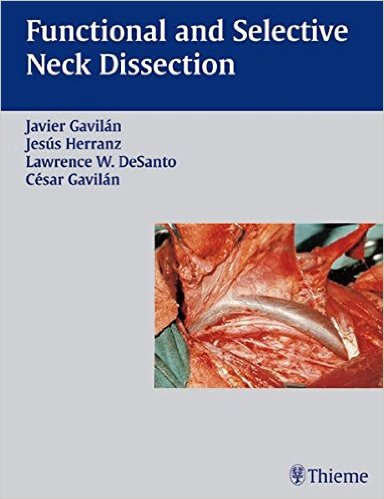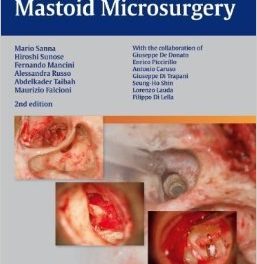Authors: Javier Gavilan, MD; Jesus Harranz, MD; Lawrence W. DeSanto,MD; and Cesar Gavilan, MD
Publisher: Thieme – 161 pages
Book Review by: Nano Khilnani
You will likely be surprised by the use of the word ‘dissection’ in the title of this book, recalling perhaps your high school biology class experience of dissecting a frog. No, the authors do not suggest the dissection of the neck in this usual sense of the use of this word. The qualifying words before the word dissection – ‘functional’ and ‘selective’ – refer to a different meaning.
As Dr. Jatin Shah, who wrote the Foreword to this book, explains it: “The authors propose ‘functional neck dissection’ as a concept and not a modification of the standard radical neck dissection. To that end, the historical perspective detailed in this textbook is impressive.”
Radical neck dissection as performed in surgeries of the early 1900s, entailed the removal, as completely as possible, of the structure of the entire lateral neck, including its entire venous system. The rationale was that metastatic cancer spreads to areas and structure not yet affected by it. In later years radical neck dissection was replaced by functional and selective dissection. In this regard the reader is urged to closely read and understand chapter 2, Rationale and Anatomical Basis for Functional and Selective Neck Dissection
Dr. Shah points out in this quoted passage, the critical importance of understanding the role of cervical lymph nodes as they metastasize or become cancerous in the head and neck region: “…the patterns of cervical lymph node metastasis has further advanced the ‘concept’ of functional neck dissection to the development and clinical applicability of selective neck dissections. Thus, the varieties of selective neck dissections currently in vogue are called extensions of the concept of a functional neck dissection, as proposed in this book.”
This book provides you – an established practitioner in otorhinolaryngology or head and neck specialist, fellow or medical resident in this specialty – a detailed textual explanation and visual tour of what ‘functional and selective neck dissection’ is, including surgical techniques, with photos of actual procedures performed by the authors. It also gives you, at the outset, a historical background since 1847 of head and neck cancers, how they were discovered and excised in numerous instances.
You will also get solutions to the demands, difficult problems and surprises you may encounter in your medical and surgical career in this field. These are based on the decades of insights developed by the authors of this unique and rare type of book on malignant tumors in the neck.
To the serious medical student as well as experienced physician-surgeon, there are always questions because ‘learning never stops,’ as the saying goes. So there is a helpful chapter at the end entitled Frequently Asked Questions, as well as list of materials to refer to for further study: Suggested Readings. We have outlined below what you will and find in this text.
- Historical Outlook
- Rationale and Anatomical Basis for Functional and Selective Neck Dissection
- Conceptual Approach to Function and Selective Neck Dissection
- Surgical Technique
- Hints and Pitfalls
- Complications
- Frequently Asked Questions
- Suggested Readings
A vitally important part of this book is chapter 4, Surgical Technique. In it, you get “a complete functional approach to the neck in which all cervical nodal groups are removed.”
Along with numerous anatomical drawings and actual photographs of surgical procedures performed, you will find in it, detailed steps presented in sequence, although not every step is mandatory for every malignant head and neck tumor. The authors caution that “surgeons must decide, based on their own personal experience, which nodal groups should be included in the dissection and which can be preserved, then proceed accordingly, skipping the surgical steps that are not necessary.”
Among the important features of this book:
- A thorough description of the fascial anatomy of the neck, vital for facilitating an effective surgical approach in head and neck cancer patients
- Conceptual explanations of functional neck dissections, augmented by hundreds of sequential operative photographs
- A synthesis of the American and Latin viewpoints in neck dissection, key to understanding the evolution of the field and integrating the best aspects f both
- A full list of technical hints and pitfalls acquired through many years of clinical experience
- A unique chapter answering the most frequently asked questions about available surgical techniques
This is an excellent, practical textbook on functional and selective neck dissection for those involved in (or learning about) the treatment of patients with head and neck cancer.
Authors:
Javier Gavilan, MD is Professor and Chairman of the Department of Otolaryngology at La Paz University Hospital in Madrid, Spain.
Jesus Harranz, MD is Section Chief of the Department of Otolaryngology at Juan Canalejo Hospital in La Coruna, Spain.
Lawrence W. DeSanto, MD is Professor and Chairman Emeritus at Mayo Medical School in Rochester, Minnesota. He is also a consultant at Mayo Clinic Scottsdale in Scottsdale, Arizona.
Cesar Gavilan, MD is Chairman of the Department of Otolaryngology at La Zarzuela Hospital in Madrid Spain.







